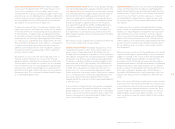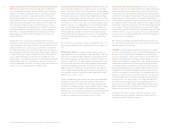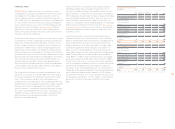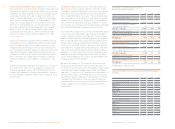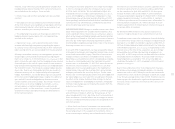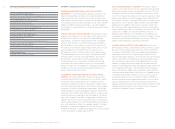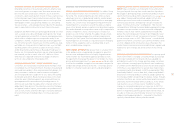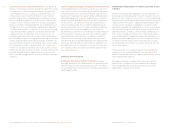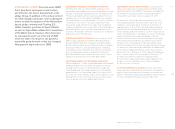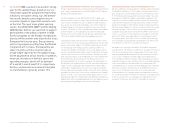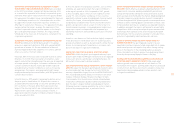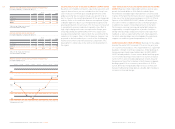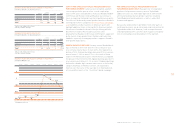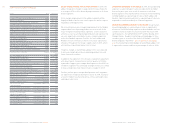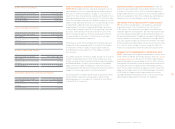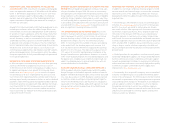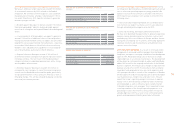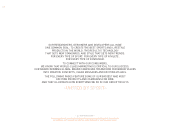Reebok 2007 Annual Report Download - page 123
Download and view the complete annual report
Please find page 123 of the 2007 Reebok annual report below. You can navigate through the pages in the report by either clicking on the pages listed below, or by using the keyword search tool below to find specific information within the annual report.119
ANNUAL REPORT 2007 --- adidas Group
03
In Asia, the region’s most populous countries, such as China
and India, are expected to remain the largest contributors
to the region’s growth in 2008. Compared to 2007, growth
in Asia excluding Japan is likely to slow slightly to a level
around 9 %, with consumer confi dence in most countries
expected to continue to grow strongly despite fi nancial market
volatility. For Japan, increased global fi nancial market
insta bility has clouded the near-term outlook and economic
growth is projected to slow to a level of no more than 2 %.
Sound corporate earnings, rising employment and encour-
aging export signals are expected to be tempered by a
weakening in domestic demand led by lackluster consumer
spending.
Growth in Latin America is likely to decline slightly compared
to the prior year to a level below 4.5 %. As in previous years,
private consumption as well as buoyant exports will be the key
drivers of economic growth. Never theless, consumer confi -
dence in the region is expected to moderate.
MIXED OUTLOOK FOR THE GLOBAL SPORTING GOODS
IN DUSTRY In 2008, the global sporting goods industry is pro-
jected to grow modestly. Although strong increases are expected
in Asia, Latin America and Europe’s emerging markets, the
US market is forecasted to decline modestly.
EUROPEAN SPORTING GOODS INDUSTRY TO GROW MODER-
ATELY We expect the European sporting goods market to grow
at a low-single-digit rate. During the fi rst half of 2008, the
industry is expected to largely focus on the UEFA EURO 2008™.
This should provide positive impetus to otherwise slow retail
markets in Western Europe. However, the impact is likely
to be somewhat less than what was initially anticipated due
to the failure of England to qualify. Traditionally, England has
been the region’s largest football licensed apparel market.
Following the event, regional growth for the sector is likely to
be driven by emerging markets, in particular Russia.
NORTH AMERICAN SPORTING GOODS MARKET EXPECTED TO
DECLINE In North America, we project a declining market in 2008.
Lower overall consumer spending coupled with promotional
activity among mall-based retailers and a polarization of price
points are likely to further burden the market. Mixed development
of product categories and distribution channels is expected to
continue throughout 2008. Whereas growth in running and soccer
footwear as well as training apparel is projected to continue, sales
in the basketball and Classics categories are expected to decline.
In addition, we expect the region’s golf market to remain highly
competitive in 2008 as many market participants introduce new
technologies that capitalize on the recent rulings by the USGA
(United States Golf Association), allowing for a broader inter-
pretation of adjustability in both metalwoods and irons.
ASIAN SPORTING GOODS INDUSTRY FORECASTED TO
EXPAND FURTHER The sporting goods market in Asia is
expected to continue to grow at a high-single-digit rate. In Japan,
weak overall private consumption may affect average selling
prices in the industry. In the emerging markets, especially
China, the industry is likely to grow at low-double-digit levels
driven by the upcoming Olympics Games in Beijing.
INCREASING TRADE BARRIERS DAMPEN LATIN AMERICAN
SPORTING GOODS INDUSTRY GROWTH Mid-single-digit
industry growth rates are expected in Latin America. The
momentum of the region’s sporting goods industry is projected
to remain intact, but there are concerns related to increasing
trade barriers being implemented in certain markets such
as Argentina and Brazil.
EXPIRATION OF AMER SOURCING AGREEMENT TO NEGA-
TIVELY IMPACT HQ / CONSOLIDATION SALES Sales recorded
in the HQ / Consolidation segment will decrease during 2008,
as a result of the expiration of the Group’s cooperation agree-
ment with Amer Sports Corporation in the fi rst quarter. Under
this agreement, the adidas Group sourced product for Salomon
at a fi xed buying commission for a limited period in an effort
to support the transfer of Salomon’s business activities to
Amer Sports Corporation. However, as this agreement includes
margins below the Group’s average, the expiration of this
contract is expected to have a positive impact on the Group’s
gross and operating margins. However, this impact will be
limited due to the small size of the business contained in the
cooperation agreement.
SLOWDOWN IN GLOBAL ECONOMIC EXPANSION PROJECTED
IN 2008 According to the World Bank, growth of the global
econ omy is expected to decline in 2008 with a projected GDP
growth rate of around 3 %. Recent turbulence in fi nancial
markets triggered by the US subprime crisis and its spillover
effects are seen as the main catalyst.
In Europe, GDP in the Euro Zone is expected to grow at a level
of below 2 % in 2008. Financial market uncertainties, lower
exports and a further strengthening of the euro are all expected
to hamper growth in the region. Consumer confi dence is fore-
casted to continue to decline mainly due to tight credit and
unstable fi nancial market conditions as well as increasing
energy prices. The region’s emerging markets will remain
largely unaffected by these uncertainties, with GDP growth fore-
casted to be around 5 %.
In North America, GDP growth is projected to decline versus
the prior year to a level below 2 %. Of particular concern is
an expected further weakening of consumer spending in the
fi rst six months of the year, driven by the persistent chal-
lenges of the housing market and continuing high oil prices.
A government-sponsored stimulus package, however, is
expected to help US consumer confi dence improve modestly
in the second half of 2008.


